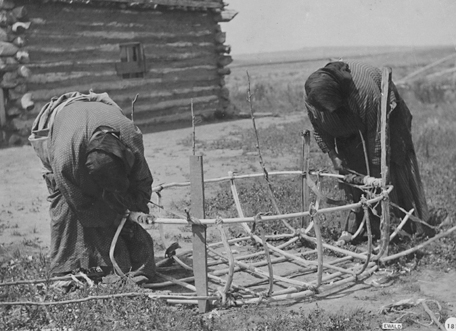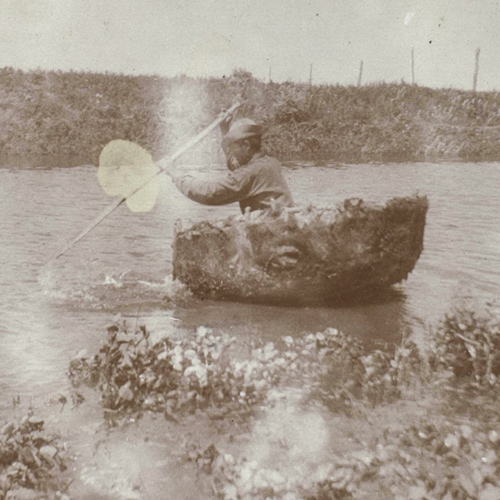Construction
These Mandan women—Owl Woman and Many Grows—are building a “compact” model, suitable for transporting one or two persons across a river. These photos were taken around 1910, when there were very few bison left in North America; the animal hide they used appears to be that of a domestic Hereford cow.
Sergeant Nathaniel Pryor, assisted by Privates Shannon, Windsor and Hall, had been assigned to drive the company’s 24 remaining horses from the vicinity of Billings, Montana to the Knife River Villages near the Corps’ Fort Mandan, drop some of them off there, and take the rest up to Fort Assiniboine in today’s Manitoba, Canada, to deal with trader Hugh Heney. But Indians stole the horses the second night out, so Pryor and his men constructed “bull boats” and floated down the Yellowstone River, catching up with Clark’s contingent on August 8 a few miles down the Missouri from today’s Williston, North Dakota.
Clark explained that Pryor and his men “killed a Buffalow Bull and made a Canoe in the form and shape of the Mandans & Rickares.” In summary, this is what Clark wrote:
Two sticks of 1-1/4 inch diameter are tied together so as to form a round hoop of the size you wish the canoe to be, or as large as the skin will cover. Two of those hoops are made, one for the top or brim, and the other for the bottom. Then sticks of the same diameter are crossed at right angles and fastened with a thongs to each hoop, and also where each stick crosses the other. Then the skin, when green [fresh, that is, not tanned] is drawn tight over the frame and fastened with thongs to the brim, or outer hoop, so as to form a perfect basin.
Pryor’s two canoes were nearly the same size, 7 feet 3 inches in diameter and 16 inches deep, with 15 ribs or cross sticks in each.
Mandan and Hidatsa Recollections
Courtesy CARLI Digital Collections, Olin D. Wheeler collection, collections.carli.illinois.edu/digital/collection/nby_eeayer/id/9060.
Text on back of photo: “An Indian Bull boat: Made of buffalo hide stretched over a willow pole framework.”
The photo above, taken around 1900, is from Olin D. Wheeler, The Trail of Lewis and Clark. See also Wheeler’s “Trail of Lewis and Clark”. Courtesy
A traveler in the Northwest in 1877 commented on the Mandans’ bull boats: “One person can carry the Bull Boat for they are very lite. A very short paddle is used and they travel around and arround in a circle motion and the Indians . . . can make very fair speed with them.”[1]He added, “there is only one place in this world the same kind of boats are made and used. That is at Bagdad on the Tigris River.” Fred G. Bond, “Flatboating on the Yellowstone, … Continue reading Paddles could be made entirely of wood, or else of sticks fastened to shoulder blades of bison.
Alexander Henry (the Younger), who traveled among the Mandans and Hidatsas in July 1806, left us a more detailed description of the Indians’ techniques: “In lieu of a paddle they use a pole about five feet long, split at one end, to admit a piece of board about two feet long and half a foot broad, which is lashed to the pole and forms a kind of cross; there is but one for each canoe. He who paddles makes directly for the opposite shore; every stroke he gives turns his dish almost entirely round; to recover his position and go on his intended route, he must give a stroke on the other hand, which brings him up again, and so on until he gets over, not without drifting down sometimes nearly a mile.”[2]Elliott Coues, ed., New Light on the Early History of the Greater Northwest (3 vols., 1897; reprint, Minneapolis: Ross & Haines, Inc., 1965), 1:331–32.
Coincidentally, Captain Lewis had resorted to bull boats to cross the Missouri River with his detail of men, when they returned to the upper portage camp on July 16, 1806. They built one boat “after the Mandan fassion with a single skin in form of a bason,” but Lewis’s irrepressible inventiveness compelled him to construct the other of two skins “on a plan of our own.” The next day he reported, “we transported our baggage and meat to the opposite shore in our canoes which we found answered even beyond our expectations.” Oh, how we wish he had left us at least a few details of his surprisingly successful—and now forever secret—plan!
“Mode of crossing rivers by the Flathead and other Indians”
ca. 1861, Gustavus Sohon (1825–1903)[3]John Mullan, Capt., Report on the Construction of a Military Road from Fort Walla-Walla to Fort Benton, (Washington: Government Printing Office, 1863).
Bowen & Co. lithographer. Archives and Special Collections, Mansfield Library, The University of Montana, Missoula.
River Worthiness
Pryor had made two boats as insurance against loss of all their guns and ammunition in case of a mishap. He was pleased to find, as he later told Clark, that “they passed through the worst parts of the rapids & Shoals in the river without takeing a drop of water, and waves raised from the hardest winds dose not effect them.” They shouldn’t have been surprised, for in the fall of 1804 (9 October 1804), Clark had remarked: “I saw at Several times to day 3 Squars in single Buffalow Skin Canoes loaded with meat Cross the River. At the time the waves were as high as I ever Saw them on the Missouri.”
Fortunately, Pryor and his companions were either really lucky or else they were quick studys, for the boats normally would have had to be dried out almost daily and treated with a mixture of tallow and ashes to keep them from becoming waterlogged.[4]Leland D. Baldwin, The Keelboat Age on Western Waters (Pittsburgh, Pennsylvania: University of Pittsburgh Press, 1941), 40-41. Their watercrafts served for a full two weeks, however, apparently without a mentionable mishap until August twelfth, when one of them received a serious puncture. They repaired the damage alright, but that afternoon they left the “leather canoes” on the bank—in accordance with accepted Indian etiquette—and proceeded on, all together, in the dugout canoes. The Corps of Discovery didn’t have time to wait for skin “basons” that bobbed along no faster than the river’s main current, and that were subject to punctures from sweeps and sawyers.
They were going home!
Notes
| ↑1 | He added, “there is only one place in this world the same kind of boats are made and used. That is at Bagdad on the Tigris River.” Fred G. Bond, “Flatboating on the Yellowstone, 1877.” From a manuscript in the New York Public Library. Bond was mistaken. A similar watercraft, called a coracle, was used in Wales. |
|---|---|
| ↑2 | Elliott Coues, ed., New Light on the Early History of the Greater Northwest (3 vols., 1897; reprint, Minneapolis: Ross & Haines, Inc., 1965), 1:331–32. |
| ↑3 | John Mullan, Capt., Report on the Construction of a Military Road from Fort Walla-Walla to Fort Benton, (Washington: Government Printing Office, 1863). |
| ↑4 | Leland D. Baldwin, The Keelboat Age on Western Waters (Pittsburgh, Pennsylvania: University of Pittsburgh Press, 1941), 40-41. |
Experience the Lewis and Clark Trail
The Lewis and Clark Trail Experience—our sister site at lewisandclark.travel—connects the world to people and places on the Lewis and Clark Trail.
Discover More
- The Lewis and Clark Expedition: Day by Day by Gary E. Moulton (University of Nebraska Press, 2018). The story in prose, 14 May 1804–23 September 1806.
- The Lewis and Clark Journals: An American Epic of Discovery (abridged) by Gary E. Moulton (University of Nebraska Press, 2003). Selected journal excerpts, 14 May 1804–23 September 1806.
- The Lewis and Clark Journals. by Gary E. Moulton (University of Nebraska Press, 1983–2001). The complete story in 13 volumes.




